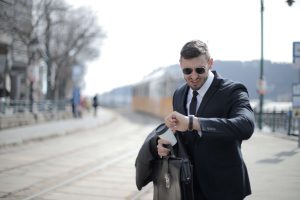Chapter 4: Nonverbal Communication
Learning Objectives
- Define nonverbal communication.
- Provide examples of the functions of nonverbal communication.
- List and define five types of nonverbal communication: kinesics, haptics, vocalics, proxemics, and chronemics.
- Describe the multichannel nature of nonverbal communication.
- Identify the outcomes and implications of nonverbal communication choices.
When we think about communication, we most often focus on how we exchange information using words. While verbal communication is important, humans relied on nonverbal communication for thousands of years before we developed the capability to communicate with words. Nonverbal communication is the process of generating meaning using behavior other than words. Rather than thinking of nonverbal communication as the opposite of or as separate from verbal communication, it’s more accurate to view them as operating side by side—as part of the same system. In this chapter, we will discuss in more detail the functions and types of nonverbal communication and conclude with some guidance on how to improve our nonverbal communication competence.
4.1 Functions of Nonverbal Communication

As you’ll recall from our introductory chapter, a channel is the sensory route on which a message travels. Oral communication only relies on one channel, because spoken language is transmitted through sound and picked up by our ears. Nonverbal communication, on the other hand, can be taken in by all five of our senses. Since most of our communication relies on visual and auditory channels, those will be the primary focus of this chapter. But we can also receive messages and generate meaning through touch, taste, and smell. Touch is an especially powerful form of nonverbal communication that we will discuss in this chapter, but we will not get into taste and smell, which have not received as much scholarly attention in relation to nonverbal communication as the other senses.
To further define nonverbal communication, we need to distinguish between vocal and verbal aspects of communication. Verbal and nonverbal communication include both vocal and nonvocal elements. A vocal element of verbal communication is spoken words—for example, “Come back here.” A vocal element of nonverbal communication is paralanguage, which is the vocalized but not verbal part of a spoken message, such as speaking rate, volume, and pitch. Nonvocal elements of verbal communication include the use of unspoken symbols to convey meaning. Writing and American Sign Language (ASL) are nonvocal examples of verbal communication and are not considered nonverbal communication. Nonvocal elements of nonverbal communication include body language such as gestures, facial expressions, and eye-contact. Gestures are nonvocal and nonverbal since most of them do not refer to a specific word like a written or signed symbol does.
Nonverbal communication has a distinct history and serves separate evolutionary functions from verbal communication. For example, nonverbal communication is primarily biologically based while verbal communication is primarily culturally based. This is evidenced by the fact that some nonverbal communication has the same meaning across cultures, while no verbal communication systems share that same universal recognizability (Andersen, 1999). Nonverbal communication also evolved earlier than verbal communication and served an early and important survival function that helped humans later develop verbal communication. While some of our nonverbal communication abilities, like our sense of smell, lost strength as our verbal capacities increased, other abilities like paralanguage and movement have grown alongside verbal complexity.
In this section, we will highlight five functions of nonverbal communication, including its ability to convey meaning, regulate conversational flow, affect relationships, express our identities, and affect how we feel about ourselves.
Nonverbal Communication Conveys Meaning

You may have heard that more meaning is generated from nonverbal communication than from verbal. Some studies have found that 65 percent or more of our meaning is derived from nonverbal signals (Guerrero & Floyd, 2006). Nonverbal communication conveys meaning by reinforcing, substituting for, or contradicting verbal communication.
As we’ve already learned, verbal and nonverbal communication are two parts of the same system that often work side by side, helping us generate meaning. In terms of reinforcing verbal communication, gestures can help describe a space or shape that another person is unfamiliar with in ways that words alone cannot. Gestures also reinforce basic meaning—for example, pointing to the door when you tell someone to leave. Facial expressions reinforce the emotional states we convey through verbal communication. For example, smiling while telling a funny story better conveys your emotions (Hargie, 2011). Vocal variation can help us emphasize a particular part of a message, which helps reinforce a word or sentence’s meaning. For example, saying “What are you doing here?” conveys a different meaning than “What are you doing here?”
Nonverbal communication can substitute for verbal communication in a variety of ways. Nonverbal communication can convey much meaning when verbal communication isn’t effective because of language barriers. Nonverbal communication is also useful in a quiet situation where verbal communication would cause a disturbance; for example, you may use a gesture to signal to a friend that you’re ready to leave the library. Crowded or loud places can also impede verbal communication and lead people to rely more on nonverbal messages. Finally, there are just times when we know it’s better not to say something aloud. If you want to point out a person’s unusual outfit or signal to a friend that you think their date is a loser, you’re probably more likely to do that nonverbally.
Last, nonverbal communication can convey meaning by contradicting verbal communication. For example, a person may say, “You can’t do anything right!” in a mean tone but follow that up with a wink, which could indicate the person is teasing or joking. Such mixed messages, or messages in which verbal and nonverbal signals contradict each other, risk causing uncertainty and confusion on the part of receivers. Mixed messages lead us to look for more information to try to determine which message is more authentic. If we are unable to resolve the discrepancy, we are likely to react negatively and potentially withdraw from the interaction (Hargie, 2011).
Nonverbal Communication Regulates Conversational Flow

Conversational interaction has been likened to a dance, where each person has to make moves and take turns without stepping on the other’s toes. Nonverbal communication helps us regulate our conversations so we don’t end up constantly interrupting each other or waiting in awkward silences between speaker turns. Pitch helps us cue others into our conversational intentions. A rising pitch typically indicates a question and a falling pitch indicates the end of a thought or the end of a conversational turn. We can also use a falling pitch to indicate closure, which can be very useful at the end of a speech to signal to the audience that you are finished, which cues the applause and prevents an awkward silence that the speaker ends up filling with “That’s it” or “Thank you.” We also signal our turn is coming to an end by stopping hand gestures and shifting our eye-contact to the person who we think will speak next (Hargie, 2011). Conversely, we can “hold the floor” with nonverbal signals even when we’re not exactly sure what we’re going to say next. Repeating a hand gesture or using one or more verbal fillers can extend our turn even though we are not verbally communicating at the moment.
Nonverbal Communication Affects Relationships
To successfully relate to other people, we must possess some skill at encoding and decoding nonverbal communication. The nonverbal messages we send and receive influence our relationships in positive and negative ways and can work to bring people together or push them apart. Nonverbal communication in the form of immediacy behaviors and expressions of emotion are just two of many examples that illustrate how nonverbal communication affects our relationships.

Immediacy behaviors play a central role in bringing people together and have been identified by some scholars as the most important function of nonverbal communication (Andersen & Andersen, 2005). Immediacy behaviors are verbal and nonverbal behaviors that lessen real or perceived physical and psychological distance between communicators and include things like smiling, nodding, making eye-contact, and occasionally engaging in social, polite, or professional touch (Comadena et al., 2007). Immediacy behaviors are a good way of creating rapport, or a friendly and positive connection between people. Skilled nonverbal communicators are more likely to be able to create rapport with others due to attention-getting expressiveness, warm initial greetings, and an ability to get “in tune” with others, which conveys empathy (Riggio, 1992). These skills are important to help initiate and maintain relationships.
While verbal communication is our primary tool for solving problems and providing detailed instructions, nonverbal communication is our primary tool for communicating emotions. This makes sense when we remember that nonverbal communication emerged before verbal communication and was the channel through which we expressed anger, fear, and love for thousands of years of human history (Andersen, 1999). Touch and facial expressions are two primary ways we express emotions nonverbally. Love is a primary emotion that we express nonverbally and that forms the basis of our close relationships. Although no single facial expression for love has been identified, it is expressed through prolonged eye-contact, close interpersonal distances, increased touch, and increased time spent together, among other things. Given many people’s limited emotional vocabulary, nonverbal expressions of emotion are central to our relationships.
Nonverbal Communication Expresses Our Identities
Nonverbal communication expresses who we are. Our identities (the groups to which we belong, our cultures, our hobbies and interests, etc.) are conveyed nonverbally through the way we set up our living and working spaces, the clothes we wear, the way we carry ourselves, and the accents and tones of our voices. Our physical bodies give others impressions about who we are, and some of these features are more under our control than others. Height, for example, has been shown to influence how people are treated and perceived in various contexts. Our level of attractiveness also influences our identities and how people perceive us. Although we can temporarily alter our height or looks—for example, with different shoes or different color contact lenses—we can only permanently alter these features using more invasive and costly measures such as cosmetic surgery. We have more control over some other aspects of nonverbal communication in terms of how we communicate our identities. For example, the way we carry and present ourselves through posture, eye-contact, and tone of voice can be altered to present ourselves as warm or distant depending on the context.

Aside from our physical body, artifacts, which are the objects and possessions that surround us, also communicate our identities. Examples of artifacts include our clothes, jewelry, and space decorations. In all the previous examples, implicit norms or explicit rules can affect how we nonverbally present ourselves. For example, in a particular workplace it may be a norm (implicit) for people in management positions to dress casually, or it may be a rule (explicit) that different levels of employees wear different uniforms or follow particular dress codes. We can also use nonverbal communication to express identity characteristics that do not match up with who we actually think we are. Through changes to nonverbal signals, a capable person can try to appear helpless, a guilty person can try to appear innocent, or an uninformed person can try to appear credible.
Nonverbal Communication Affects How We Feel About Ourselves

Our nonverbal behaviors not only affect how others view us, but how we view ourselves. Changing our nonverbal signals can affect our own thoughts and emotions. Knowing this allows us to have more control over the trajectory of our communication, possibly allowing us to intervene in a negative cycle. For example, if you are waiting in line to get your driver’s license renewed and the agents in front of you are moving slower than you’d like and the man in front of you doesn’t have his materials organized and is asking unnecessary questions, you might start to exhibit nonverbal clusters that signal frustration. You might cross your arms, a closing-off gesture, and combine that with wrapping your fingers tightly around one bicep and occasionally squeezing, which is a self-touch adaptor that results from anxiety and stress. The longer you stand like that, the more frustrated and defensive you will become, because that nonverbal cluster reinforces and heightens your feelings. Increased awareness about these cycles can help you make conscious moves to change your nonverbal communication and, subsequently, your cognitive and emotional states (McKay et al., 1995).
4.2 Types of Nonverbal Communication
Just as verbal language is broken up into various categories, there are also different types of nonverbal communication. As we learn about each type of nonverbal signal, keep in mind that nonverbals often work in concert with each other, combining to repeat, modify, or contradict the verbal message being sent.
Kinesics
The word kinesics comes from the root word kinesis, which means “movement,” and refers to the study of hand, arm, body, and face movements. Specifically, this section will outline the use of gestures, head movements and posture, eye-contact, and facial expressions as nonverbal communication.
Gestures
There are three main types of gestures: adaptors, emblems, and illustrators (Andersen, 1999). Adaptors are touching behaviors and movements that indicate internal states typically related to excitement or anxiety. Adaptors can be targeted toward the self, objects, or others. In regular social situations, adaptors result from uneasiness, anxiety, or a general sense that we are not in control of our surroundings. Many of us subconsciously click pens, shake our legs, or engage in other adaptors during classes, meetings, or while waiting as a way to do something with our excess energy. Public speaking students who watch video recordings of their speeches notice nonverbal adaptors that they didn’t know they used. In public speaking situations, people most commonly use self- or object-focused adaptors.

Emblems are gestures that have a specific agreed-on meaning. A hitchhiker’s raised thumb, the “OK” sign with thumb and index finger connected in a circle with the other three fingers sticking up, and the raised middle finger are all examples of emblems that have an agreed-on meaning or meanings with a culture.
Illustrators are the most common type of gesture and are used to illustrate the verbal message they accompany. For example, you might use hand gestures to indicate the size or shape of an object. Unlike emblems, illustrators do not typically have meaning on their own and are used more subconsciously than emblems. These largely involuntary and seemingly natural gestures flow from us as we speak but vary in terms of intensity and frequency based on context. Although we are never explicitly taught how to use illustrative gestures, we do it automatically. Think about how you still gesture when having an animated conversation on the phone even though the other person can’t see you.
Head Movements and Posture
Head movements and posture are often both used to acknowledge others and communicate interest or attentiveness. In terms of head movements, a head nod is a universal sign of acknowledgement in cultures where the formal bow is no longer used as a greeting. In these cases, the head nod essentially serves as an abbreviated bow. An innate and universal head movement is the headshake back and forth to signal “no.” This nonverbal signal begins at birth, even before a baby has the ability to know that it has a corresponding meaning. We also move our head to indicate interest. For example, a head up typically indicates an engaged or neutral attitude, a head tilt indicates interest and is an innate submission gesture that exposes the neck and subconsciously makes people feel more trusting of us, and a head down signals a negative or aggressive attitude (Pease & Pease, 2004).
There are four general human postures: standing, sitting, squatting, and lying down (Hargie, 2011). Within each of these postures there are many variations, and when combined with particular gestures or other nonverbal cues they can express many different meanings. Most of our communication occurs while we are standing or sitting. One interesting standing posture involves putting our hands on our hips and is a nonverbal cue that we use subconsciously to make us look bigger and show assertiveness. When the elbows are pointed out, this prevents others from getting past us as easily and is a sign of attempted dominance or a gesture that says we’re ready for action. In terms of sitting, leaning back shows informality and indifference, while leaning forward shows interest and attentiveness (Pease & Pease, 2004).

Eye-Contact
We also communicate through eye behaviors, primarily eye-contact. While eye behaviors are often studied under the category of kinesics, they have their own branch of nonverbal studies called oculesics, which comes from the Latin word oculus, meaning “eye.” The face and eyes are the main point of focus during communication, and along with our ears our eyes take in most of the communicative information around us.
Eye-contact serves several communicative functions, ranging from regulating interaction to monitoring interaction, to conveying information, to establishing interpersonal connections. For example, we use eye-contact to signal to others that we are ready to speak or we use it to cue others to speak. I’m sure we’ve all been in that awkward situation where a teacher asks a question, no one else offers a response, and the teacher looks directly at us as if to say, “What do you think?” In that case, the teacher’s eye-contact is used to cue us to respond. Other specific functions of eye-contact include:
- Regulating interaction and providing turn-taking signals
- Monitoring communication by receiving nonverbal communication from others
- Signaling cognitive activity (we look away when processing information)
- Expressing engagement (we show people we are listening with our eyes)
- Conveying intimidation
- Expressing flirtation
- Establishing rapport or connection
Facial Expressions
Our faces are the most expressive part of our bodies. Think of how photos are often intended to capture a particular expression “in a flash” to preserve for later viewing. Even though a photo is a snapshot in time, we can still interpret much meaning from a human face caught in a moment of expression, and basic facial expressions are recognizable by humans all over the world.

Smiles are powerful communicative signals and a key immediacy behavior. Although facial expressions are typically viewed as innate and several are universally recognizable, they are not always connected to an emotional or internal biological stimulus; they can actually serve a more social purpose. For example, most of the smiles we produce are primarily made for others and are not just an involuntary reflection of an internal emotional state (Andersen, 1999). These social smiles, however, are slightly but perceptibly different from more genuine smiles. People generally perceive smiles as more genuine when the other person smiles “with their eyes.” This particular type of smile is difficult if not impossible to fake because the muscles around the eye that are activated when we spontaneously or genuinely smile are not under our voluntary control. It is the involuntary and spontaneous contraction of these muscles that moves the skin around our cheeks, eyes, and nose to create a smile that’s distinct from a fake or polite smile (Evans, 2001). People are able to distinguish the difference between these smiles, which is why photographers often engage in cheesy joking with adults or use props with children to induce a genuine smile before they snap a picture.
In the context of public speaking, facial expressions help set the emotional tone for a speech. In order to set a positive tone before you start speaking, briefly look at the audience and smile to communicate friendliness, openness, and confidence. Beyond your opening and welcoming facial expressions, facial expressions communicate a range of emotions and can be used to infer personality traits and make judgments about a speaker’s credibility and competence. Facial expressions can communicate that a speaker is tired, excited, angry, confused, frustrated, sad, confident, smug, shy, or bored. Even if you aren’t bored, for example, a slack face with little animation may lead an audience to think that you are bored with your own speech, which isn’t likely to motivate them to be interested. So make sure your facial expressions are communicating an emotion, mood, or personality trait that you think your audience will view favorably, and that will help you achieve your speech goals.
Vocalics
We learned earlier that paralanguage refers to the vocalized but nonverbal parts of a message. Vocalics is the study of paralanguage, which includes the vocal qualities that go along with verbal messages, such as pitch, volume, rate, vocal quality, and verbal fillers (Andersen, 1999).
Pitch helps convey meaning, regulate conversational flow, and communicate the intensity of a message. Even babies recognize a sentence with a higher pitched ending as a question. We also learn that greetings have a rising emphasis and farewells have falling emphasis. Of course, no one ever tells us these things explicitly; we learn them through observation and practice. We do not pick up on some more subtle or complex patterns of paralanguage involving pitch until we are older. Children, for example, have a difficult time perceiving sarcasm, which is usually conveyed through paralinguistic characteristics like pitch and tone rather than the actual words being spoken (Andersen, 1999).
Paralanguage provides important context for the verbal content of speech. For example, volume helps communicate intensity. A louder voice is usually thought of as more intense, although a soft voice combined with a certain tone and facial expression can be just as intense. We typically adjust our volume based on our setting, the distance between people, and the relationship. In our age of computer-mediated communication, TYPING IN ALL CAPS is usually seen as offensive, as it is equated with yelling. A voice at a low volume or a whisper can be very appropriate when sending a covert message or flirting with a romantic partner, but it wouldn’t enhance a person’s credibility if used during a professional presentation.
Speaking rate refers to how fast or slow a person speaks and can lead others to form impressions about our emotional state, credibility, and intelligence. As with volume, variations in speaking rate can interfere with the ability of others to receive and understand verbal messages. A slow speaker could bore others and lead their attention to wander. A fast speaker may be difficult to follow, and the fast delivery can distract from the message. Whether speaking quickly or slowly, it is important that a speaker also clearly articulate and pronounce their words.
Our tone of voice can be controlled somewhat with pitch, volume, and emphasis, but each voice has a distinct quality or vocal signature. Voices vary in terms of resonance, pitch, and tone, and some voices are more pleasing than others. People typically find pleasing voices that employ vocal variety and are not monotone.
Vocal fillers are sounds that fill gaps in our speech as we think about what to say next. They are considered a part of nonverbal communication because they are not like typical words that stand in for a specific meaning or meanings. Vocal fillers such as “um,” “uh,” “like,” and “so” are common in regular conversation and are not typically disruptive. As we learned earlier, the use of vocal fillers can help a person “keep the floor” during a conversation if they need to pause for a moment to think before continuing on with verbal communication. Vocal fillers in more formal settings, like a public speech, can be a distraction and hurt a speaker’s credibility.
Haptics

Think of how touch has the power to comfort someone in moments of sorrow when words alone cannot. This positive power of touch is countered by the potential for touch to be threatening because of its connection to sex and violence. To learn about the power of touch, we turn to haptics, which refers to the study of communication by touch.
We probably get more explicit advice and instruction on how to use touch than any other form of nonverbal communication. A lack of nonverbal communication competence related to touch could have negative interpersonal consequences. For example, if we don’t follow the advice we’ve been given about the importance of a firm handshake, a person might make negative judgments about our confidence or credibility. A lack of competence could have more dire negative consequences, including legal punishment, if we touch someone inappropriately (intentionally or unintentionally). Touch is necessary for human social development, and it can be welcoming, threatening, or persuasive.
Preferences for communicating through touch vary both culturally and individually. For example, while shaking hands might be the most common greeting in the United States, cheek kissing is commonly used in parts of the Middle East. Meanwhile, at the individual level, people might have different preferences for hugging or holding hands. The standards for touch in professional and social situations are often formal and ritualized, but individual preferences make the rules more ambiguous among friends, family, and romantic partners. Individuals must negotiate their own comfort levels with various types of touch and may encounter some uncertainty if their preferences don’t match up with their relational partner’s.
Proxemics
Proxemics refers to the study of how space and distance influence communication. We only need look at the ways in which space shows up in common metaphors to see that space, communication, and relationships are closely related. For example, when we are content with and attracted to someone, we say we are “close” to them. When we lose connection with someone, we may say that we are “distant.” In general, space influences how people communicate and behave. To better understand how proxemics functions in nonverbal communication, we will more closely examine the proxemic distances associated with personal space and the concept of territoriality.
We all have varying definitions of what our “personal space” is, and these definitions are contextual and depend on the situation and the relationship. Although our bubbles are invisible, people are socialized into the norms of personal space within their cultural group. Scholars have identified four zones for US Americans, which are public, social, personal, and intimate distance (Hall, 1968).
Public Space (12 Feet or More)
Public space starts about twelve feet from a person and extends out from there. This is the least personal of the four zones and would typically be used when a person is engaging in a formal speech and is removed from the audience to allow the audience to see or when a high-profile or powerful person like a celebrity or executive maintains such a distance as a sign of power or for safety and security reasons. In terms of regular interaction, we are often not obligated or expected to acknowledge or interact with people who enter our public zone. It would be difficult to have a deep conversation with someone at this level because you have to speak louder and don’t have the physical closeness that is often needed to promote emotional closeness and/or establish rapport.

Social Space (4-12 Feet)
Communication that occurs in the social zone, which is four to twelve feet away, is typically in the context of a professional or casual interaction, but not intimate or public. This distance is preferred in many professional settings because it reduces the suspicion of any impropriety. The expression “keep someone at an arm’s length” means that someone is kept out of the personal space and kept in the social/professional space. If two people held up their arms and stood so just the tips of their fingers were touching, they would be around four feet away from each other, which is perceived as a safe distance because the possibility for intentional or unintentional touching doesn’t exist. The closer that people advance into our social zone, the more we feel obligated to at least acknowledge their presence.
Personal Space (1.5-4 Feet)
Much of our communication occurs in the personal zone, which is what we typically think of as our “personal space bubble” and extends from 1.5 feet to 4 feet away. We are most comfortable interacting with friends, close acquaintances, and significant others in this zone. This zone can help facilitate meaningful conversation, self-disclosure, and feelings of closeness—but even people who know each other could be uncomfortable spending too much time in this zone unnecessarily.
Intimate Space (0-1.5 Feet)
As we breach the invisible line that is 1.5 feet from our body, we enter the intimate zone, which is reserved for only our closest friends, family, and romantic partners. It is impossible to completely ignore people when they are in this space, even if we are trying to pretend that we’re ignoring them. A breach of this space can be comforting in some contexts and annoying or frightening in others.
So what happens when our space is violated? Although these zones are well established in research for personal space preferences of US Americans, individuals vary in terms of their reactions to people entering certain zones, and determining what constitutes a “violation” of space is subjective and contextual. For example, another person’s presence in our social or public zones doesn’t typically arouse suspicion or negative physical or communicative reactions, but it could in some situations or with certain people. However, many situations lead to our personal and intimate space being breached by others against our will, and these breaches are more likely to be upsetting, even when they are expected. We’ve all had to get into a crowded elevator or wait in a long line. In such situations, we may rely on some verbal communication to reduce immediacy and indicate that we are not interested in closeness and are aware that a breach has occurred. People make comments about the crowd, saying, “We’re really packed in here like sardines,” or use humor to indicate that they are pleasant and well-adjusted and uncomfortable with the breach like any “normal” person would be.
Chronemics

We likely all have friends who are chronically late. Think about what their use of time communicates about them. They could be labeled as inconsiderate, disorganized, free-spirited, or busy. Regardless, their treatment of time communicates something about them as individuals and about their relationships with others. This demonstrates the importance of chronemics, or the study of how time affects communication.
The way we experience time varies based on our mood, our interest level, and other factors. Think about how quickly time passes when you are interested in and therefore engaged in something. I have taught fifty-minute classes that seemed to drag on forever and three-hour classes that zipped by. Individuals also vary based on whether they are future- or past-oriented. People with past-time orientations may want to reminisce about the past, reunite with old friends, and put considerable time into preserving memories and keepsakes in scrapbooks and photo albums. People with future-time orientations may spend the same amount of time making career and personal plans, writing out to-do lists, or researching future vacations, potential retirement spots, or what book they’re going to read next.
Cultural factors also impact how we view time. Polychronic people keep more flexible schedules and may engage in several activities at once. Monochronic people tend to schedule their time more rigidly and do one thing at a time. A polychronic or monochronic orientation to time influences our social realities and how we interact with others.
Additionally, the way we use time depends in some ways on our status. For example, doctors can make their patients wait for extended periods of time, and executives and celebrities may run consistently behind schedule, making others wait for them. Promptness and the amount of time that is socially acceptable for lateness and waiting varies among individuals and contexts.
Nonverbal Congruence
As this overview of different types of nonverbal communication has demonstrated, nonverbal communication is multichannel, and we rarely send a nonverbal message in isolation. For example, a posture may be combined with a touch or eye behavior to create what is called a nonverbal cluster (Pease & Pease, 2004). Nonverbal congruence refers to consistency among different nonverbal expressions within a cluster. Congruent nonverbal communication is more credible and effective than ambiguous or conflicting nonverbal cues. Even though you may intend for your nonverbal messages to be congruent, they could still be decoded in a way that doesn’t match up with your intent, especially since nonverbal expressions vary in terms of their degree of conscious encoding. In this sense, the multichannel nature of nonverbal communication creates the potential of both increased credibility and increased ambiguity.
When we become more aware of the messages we are sending, we can monitor for nonverbal signals that are incongruent with other messages or may be perceived as such. If a student is talking to his professor about his performance in the class and concerns about his grade, the professor may lean forward and nod, encoding a combination of a body orientation and a head movement that conveys attention. If the professor, however, regularly breaks off eye-contact and looks anxiously at her office door, then she is sending a message that could be perceived as disinterest, which is incongruent with the overall message of care and concern she probably wants to encode. Increasing our awareness of the multiple channels through which we send nonverbal cues can help us make our signals more congruent in the moment.
Key Concepts: Impression Management
Our nonverbal communication helps us express our identities and play a crucial part in impression management. Being able to control nonverbal expressions and competently encode them allows us to better manage our persona and project a desired self to others—for example, a self that is perceived as competent, socially attractive, and engaging. Being nonverbally expressive during initial interactions usually leads to more favorable impressions. So smiling, keeping an attentive posture, and offering a solid handshake help communicate confidence and enthusiasm that can be useful on a first date, during a job interview, when visiting family for the holidays, or when running into an acquaintance at the grocery store. Nonverbal communication can also impact the impressions you make as a student. Research has also found that students who are more nonverbally expressive are liked more by their teachers and are more likely to have their requests met by their teachers (Mottet et al., 2004).
Discussion Questions:
- Discuss how each of the five categories of nonverbal communication (kinesics, haptics, vocalics, proxemics, and chronemics) play a role in impression management.
- Identify some nonverbal behaviors that would signal a positive interaction on a first date and on a job interview. Then identify some nonverbal behaviors that would signal a negative interaction in each of those contexts.
References
Andersen, P. A. (1999). Nonverbal communication: Forms and functions. Waveland Press.
Andersen, P. A., & Anderson, J. F. (2005). Measures of perceived nonverbal immediacy. In V. L. Manusov (Ed.), The sourcebook of nonverbal measures: Going beyond words (pp. 113–126). Lawrence Erlbaum.
Comadena, M. E., Hunt, S. K., & Simonds, C. J. (2007). The effects of teaching clarity, nonverbal immediacy, and caring on student motivation, affective and cognitive learning. Communication Research Reports, 24(3), 241–248. https://doi.org/10.1080/08824090701446617.
Evans, D. (2001). Emotion: The science of sentiment. Oxford University Press.
Guerrero, L. K. & Floyd, K. (2006). Nonverbal communication in close relationships. Lawrence Erlbaum.
Hall, E. T. (1968). Proxemics. Current Anthropology, 9(2), 83–95. https://doi.org/10.1086/200975.
Hargie, O. (2011). Skilled interpersonal interaction: Research, theory, and practice (5th ed.). Routledge.
Mottet, T. P., Beebe, S. A., Raffeld, P. C., & Paulsel, M. L. (2004). The effects of student verbal and nonverbal responsiveness on teachers’ liking of students and willingness to comply with student requests. Communication Quarterly, 52(1), 27–38. https://doi.org/10.1080/01463370409370176.
McKay, M., Davis, M., & Fanning, P. (1995). Messages: Communication skills book (2nd ed.). New Harbinger Publications.
Pease, A., & Pease, B. (2004). The definitive book of body language. Bantam.
Riggio, R. E. (1992). Social interaction skills and nonverbal behavior. In R. S. Feldman (Ed.), Applications of nonverbal behavior theories and research (pp. 3–30). Lawrence Erlbaum.
Credits
Chapter 4 was adapted, remixed, and curated from Chapter 4 of Communication in the Real World: An Introduction to Communication Studies, a work produced and distributed under a CC BY-NC-SA license in 2013 by a publisher who has requested that they and the original author not receive attribution.
